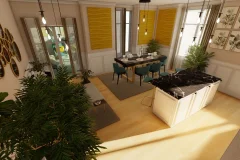Champagne Ardenne Description and Information
Champagne-Ardenne Departments
- Ardennes (08)
- Aube (10)
- Haute-Marne (52)
- Marne (51)
Champagne-Ardenne, little-known but charming region
Wide-ranging Natural Surroundings
Champagne-Ardenne borders Ile-de-France in the south-west, the industrial areas of Lorraine in the east, and Belgium in the north. Its name comes from the Romans who called it Campania, meaning literally "Land of the Plains". Today in these plains, mostly to the south of the region, vast quantities of cereals and maize are grown. Sugar beet is a major crop (the smell from the sugar beet refineries can be overpowering so do not consider buying a property anywhere near one!) and the region grows more wheat and cabbage than any other. The rolling prairies that give the region its name are located in the south between Reims/Epernay and Troyes. North of Reims the landscape becomes a flat chalky plain which is wet, bitterly cold and very windy during winter. This area is an extension of the chalk subsoil that comes to the surface at Calais and forms the White Cliffs of Dover on the opposite side of the Channel. Closer to the border with Belgium, the landscape becomes more rugged and deeply forested.
A Mostly Rural Region
But cabbage aside, it is of course better known for a much more glamorous crop: the white grape that has produced Champagne's eponymous sparkly wine since the days of Dom Perignon. Only bubbly made from vines from limited parts of the region can be called Champagne and these are mainly located in the Marne and Aube departments. Away from the lush vineyards surrounding the towns of Reims, Epernay and Troyes, much of the rural region is somehow secluded and perfect to revive a bygone way of life.
Top Tip! The largest artificial lake in Europe - Lac de Der-Chatecoq - found in the forested Ardennes, is beginning to attract tourists with an interest in walking and boating.
An Economy Based upon Industry
Agriculture is a strong force in the economy and the region's production accounts for one-third of the regional output (representing 2.3% of France's gross domestic product). In addition to traditional agricultural and manufacturing (metalworking and textiles) activities, Champagne Ardenne has become a major industrial base for the agrofoods industry. Other industrial sectors include packaging, automotive equipment (Citroën is a large employer), tire manufacturing, plastics, and chemicals. Companies choose this region for its lower wages compared with those of nearby Belgium and reputedly a low level of absenteeism.
Countryside Life & Local Produce
Gastronomy in Champagne-Ardenne has always been a true tradition. It is well worth a visit, since its gastronomy can be described as varied, rich and authentic. Every meal is an actual experience, and you must taste local specialities as sausages, cheeses, pig’s trotter, biscuits, cider or wine, and, last but not least, Champagne. The region is currently not very popular with second home buyers, but for anyone wishing to venture this way, inexpensive property can be found.
Champagne-Ardennes Population
- Population: 1,342,363
- Pop. density (people per km2): 62









